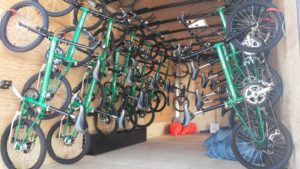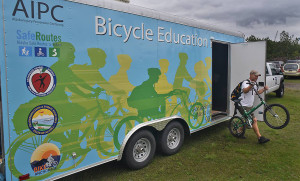Bringing Bike Education to the Classroom
Big Dream Made Real
Many in Anchorage’s bike advocacy community have long dreamed of having a bike fleet available for education offerings for children. Teaching bike safety to a classroom of students or a group of children can pose hundreds of logistical challenges. It can take hours of coordination to make sure that each student has a bike, and helmet, in proper working order. Anne Schlapia with the Anchorage Department of Health & Human Services has provided on the bike training and education to groups of kids for years. Schlapia says that the bikes kids brought to a class were often in “such poor shape that they could not be used” and that so much time that could be dedicated to skills training and riding was spent repairing bikes. Having a fleet of maintained bikes eliminates many of those logistical challenges. In spring of 2015, Alaska Injury Prevention Center received funding from Alaska’s Safe Routes to School Program to put together a bike fleet for the Anchorage School District.
The Bikes
AIPC modeled its fleet after those put together by Eugene, Oregon’s Safe Routes to School coordinator, Shane MacRhodes. MacRhodes, a graduate of Anchorage’s West High School, had traveled to Anchorage in the fall of 2014 to teach a League of American Bicyclist’s instructor course. While in town, he shared information about the many bicycle education and advocacy efforts he coordinates in Eugene. “We’ve been doing bike safety education in Eugene for over a decade and have learned a lot over the years about what works best for students, instructors, and coordinators when it comes to fleet and equipment for training,” MacRhodes says. For MacRhodes, Bike Friday’s OSATA bikes proved perfect for their fleet needs as “adjustable, high-quality, standardized, and locally made.” Bike Friday’s OSATA, or one size adjusts to all bicycles, are capable of adjusting to fit riders from 4’0” to 6’2” and up to 200 pounds. They are also made in Eugene, Oregon of Made in America steel—a rarity for children’s bikes.
Storage and Transportation
To house and transport the bikes, AIPC worked with White Spruce Trailers in Anchorage to set up a 20” trailer with the proper hooks and storage for the fleet. The trailer also was outfitted to hold a supply cabinet filled with materials such as cones and signs for setting up a bike skills course, as well as the tools needed for simple maintenance and upkeep of the bikes. The trailer will also be stocked with plenty of helmets for each student and students are welcome to bring in their own helmet if they prefer. ASD Health and Physical Education teachers will be able to reserve and check out the trailer through an online request system and have the trailer delivered directly to their school.
Curriculum
Classroom and on-the-bike instruction will be taught using the Bikeology curriculum. The Bikeology curriculum was designed by the American Alliance for Health, Physical Education, Recreation and Dance with funding from the National Highway Traffic Safety Administration. The Bikeology curriculum was created for pre-teen and teen students in grades 6-12. The curriculum meets National Standards for K-12 Physical Education and has been found effective in increasing bicycle safety knowledge and skills for students.
To familiarize teachers with the curriculum, Bike Anchorage and Alaska Injury Prevention Center partnered to coordinate a two-day CEU offering for ASD health and PE teachers at this year’s ASD Summer Academy. A total of 8 teachers completed the course comprised of classroom education and on-the-bike training and drills. Teachers had time to review the Bikeology curriculum and practice setting up and organizing classroom drills that could be used with their students. Teachers overwhelmingly appreciated the course. Many were also excited about the possibility of having a fleet of bikes at their disposal. “The bike trailer will enable the ASD Physical Education teachers to provide active learning about the health benefits of cycling, bikes, bike maintenance, and riding safely and efficiently,” says Melanie Sutton, the Health and Physical Education Coordinator for the Anchorage School District. “We are excited to work with our community partners to enhance our current programs by finding innovative ways to engage our students and increase our ability to provide an equal playing field for students to learn about the benefits gained from being physically active as well as the skills and knowledge to incorporate safe, satisfying physical activity into their lives.”
Alaska Injury Prevention Center and community partners look forward to equipping the next generation of Anchorage bicyclists with the skills and knowledge to confidently and safely bicycle, whether for exercise or transportation.


